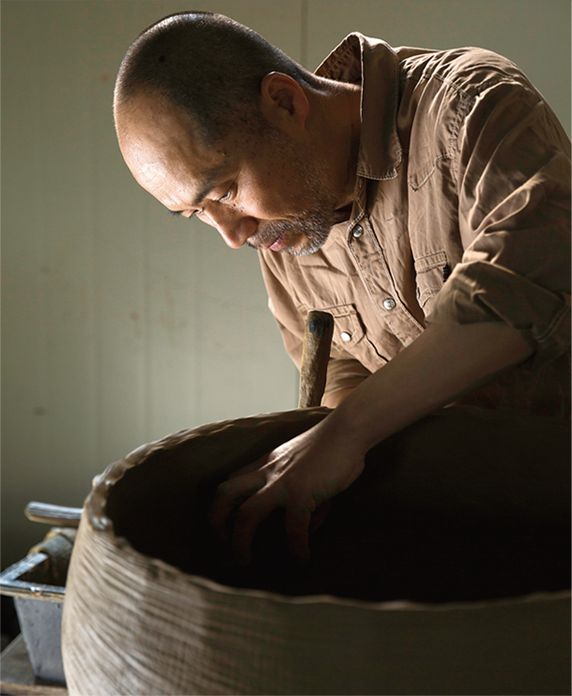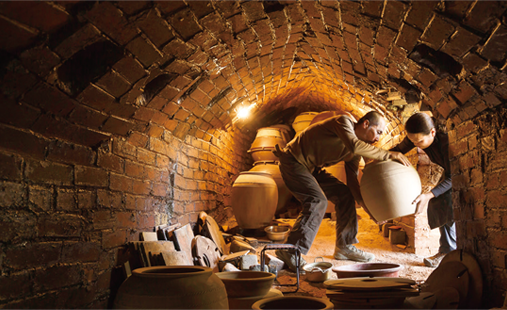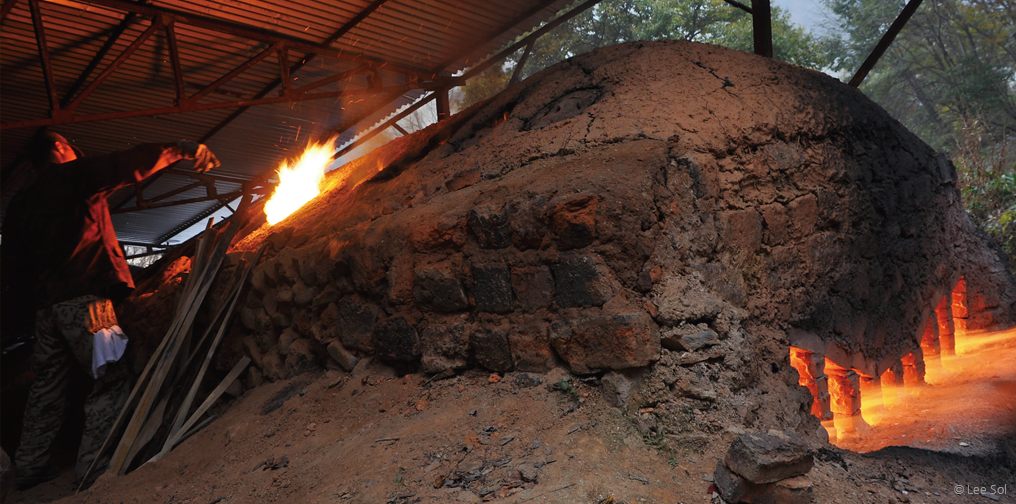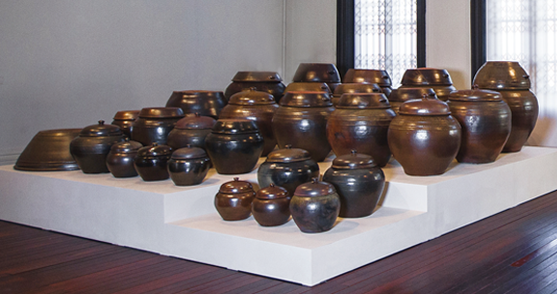In traditional arts and crafts, artisans of the past learned their craft through apprenticeship and spoke of theirart only through their handiwork. lee Hyun-bae, however, is a new-generation artisan. the master potterlearned onggi pottery (traditional Korean earthenware) through words and writings; he thinks deeply abouteach procedure of his work, concerning himself with modern applications of traditional culture.

The master onggi artisan Lee Hyun-baeshapes the rim of a large jar on his wheelat his workshop in Jinan, North JeollaProvince.
Listening to Lee Hyun-bae talk was like reading a written text.Whenever he paused groping for the next words, thoughtswould rise, gather, or scatter in my head. I felt that way listeningto his story about a time when he had been working at a potterystore for five months. He said he had felt “a sudden burst of energy”on looking at a shard of a broken pot. At the time, he had neverbaked a vessel, but was just trying to seize an opportunity to developan eye for quality while working as a clerk. Calling it an “eyeopeningmoment,” he added, “Pondering later why I had felt suchenergy, I remembered that the shard’s cross section was in theshape of a sperm. The fragment was broken off from a pot’s mouth,so the cross section of the rounded rim, called jeon, looked like asperm’s head and the remaining part its tail. Just as a sperm’s headcarries all the genetic information, an onggi pot also has its informationin the round rim.”
It was a story tuned to the theme of onggi ware and vitality, astory as articulate as his pottery skills, although I must say I wasnot fully convinced yet. However, it was just a small portion of thenarrative he was building up, which at times took unexpected turnsto make a point in a broader context. When talking about potterywheels, for example, he went on to discuss certain details, such ashis line of vision: “With the wheel in front, I sit on the mat with thesun to my right. I lean to that direction, pushing the treadle with myleft foot, turning the wheel counterclockwise, and looking at theright side of the pot, its outer surface.”
The master artisan’s remarks, covering diverse topics with earnestness,offered a glimpse of his wisdom ripened by time. Not aword was uttered without thought.
It was as if he had sorted out allthe strands constituting his idea of onggi pottery, assigning meaningto every one of them. It seemed as though he had reinterpretedthe 26 years of his life as a potter entirely through the prism of hiscraft, and found a way to express it in clear language. His wordsreflected the broad scope of his thinking.
And yet, there was a hint of desperation in the way he built up thenarrative — a desperate struggle to bring onggi pottery, submergedin the obscurity of tradition, up to the surface of today’s life, and todefine his contemporary role as a potter. Driven by such a strongsense of mission, he looked robust like a solid piece of onggi ware,the clay structure that withstands heat exceeding 1,000ºC withoutbuckling.
A Chance Encounter in His Wandering Days

Lee and his wife work together arranginghis well-dried onggi jars and lids inside thekiln for firing.
“In my childhood, I was nicknamed Golbae, meaning an emptyheadedboy. People kept telling me to think before acting,” said Leewith a big laugh, his face all creased up. It was a laugh wrappedaround the recollection of an embarrassing past. “I always wishedto be somewhere else, but I would wake up every morning disappointedthat I was still there. With my heart burning with inexplicableanger, I would howl and scream, only to feel afterward a void inmy heart. After such solitary tantrums, I would storm out and run tostand on a riverbank, listening to the sound of water. It was the firstsound that I would hear coming back to my senses,” recalled theartisan.
So he named his first child Mul (meaning “water”) and settleddown at the head of the Seomjin River.
In his teens, when he wasdriven by wild emotions, he would run away from home to go toSeoul, or roam around his hometown pushing a cart to collect junkto make a living. For some time later, he worked at a hotel kitchenmaking chocolates and leading a comfortable life. Before long,however, fascinated by a sculpture in the hotel lobby, he decided tostudy sculpture and start a new life. In the midst of his confusion, hestopped by the Jinggwang Onggi Shop on a trip to Beolgyo, SouthJeolla Province, and this chance encounter became a turning pointin his life.
“When they asked me what brought me there, I answered beforeI knew it that I wished to learn onggi pottery,” Lee recollected, adding,“At that time, I used to spend every night reading back issues of‘Deep Rooted Tree,’ a popular cultural magazine widely circulatedin the late 1970s. Reading one of its articles about onggi pottery,I remember thinking, ‘This must be a job to avoid.’ Onggi potters could barely make ends meet, the article said, and going hungryhad been my worst fear since childhood.”
“Firing pottery and fermenting food are similar in pattern because both are vital processes.The vessels quickly baked in a modern gas kiln cannot be the same as those fired tenderly anddelicately in a wood-fired kiln for almost a week. Their fermentation capacities are different.”

Stoking up the fire, Lee feeds more wood into the kiln to maintain the firing temperature.After the fire is lit, it takes about seven days until the glaze on the surface of theheated pottery is melted, the last step of the firing process.
It was a time when onggi ware was falling out of favor fora number of reasons, including the widespread use of plasticgoods and the scandal around the detection of lead in thechemical glaze, a substitute for the traditional natural lye, whichresulted in a loss of trust in traditional earthenware. After allthat, his time at Jinggwang Onggi Shop — two years and sevenmonths, starting from 1990 — may be difficult to explain in away that makes sense. Unlike most stories about the earlycareers of eminent artisans, there was no period of apprenticeshipunder an almighty master, whom he would have emulatedto learn his skills. He was just managing the store, arrangingthe merchandise, and only occasionally had an opportunity toappreciate the works of Park Na-seop, a master potter whosometimes dropped by the shop. In his reminiscence of thattime, two names came up repeatedly: Han Chang-gi, the publisherof Deep Rooted Tree, and Han Sang-hun, his youngerbrother and owner of the Jinggwang Onggi Shop. Declaring thathe cultivated his aesthetic discernment through his associationwith these two men, Lee recalled, “In the store, we would callthe publisher Grand Master and the owner Master. But the potterPark Na-seop we addressed just as Sir. Later, I would wonderwhy I had the talkers, not the doer, as my teachers. Thenagain, the easiest way to learn about onggi pottery might bethrough words.”
At some point after this unconventional learning process, hewas expected to immediately take over the responsibility of supplyingonggi ware to the shop. Acquired mostly through observation,his skills were still incomplete, so his vessels wouldshatter in firing, or the kiln would collapse before his very eyes.He felt an urgent need to bring order to this chaotic situation.Eventually, however, he overcame difficulties and has been“able to make the products without a hitch since 1994.” In time,he opened Sonnae Onggi Shop in Jinan and started to sell hisown wares.
Clay, Fire, Wind, and Sunlight
Was the disjointed few years’ stint enough for him to learn?Why did he not try to learn more? He fell silent, seeminglysearching for words, and then answered, “Well, the skills formaking onggi vessels are … rather simple.”
It may indeed be a simple craft because it only involves wheelthrowing, glazing, and firing. Nevertheless, the potter shouldcommunicate with the clay, fire, and air to produce a decentpiece of onggi ware. Lee explained: “The clay is either dead oralive. You can tell by the color. Dead clay tastes different and hasa unique smell. It cannot hold tight, so it tends to droop whenyou throw it. An onggi vessel made with dead clay feels heavier— even when the same amount of clay is used — and tends to buckle under the heat of the kiln.”
Featured at the exhibition “Today’s Onggi: Lee Hyun-bae” held last winter at the southern branch of the SeoulMuseum of Art, an array of funerary urns are the products of the project that Lee and the Naju National ResearchInstitute of Cultural Heritage have conducted since 2008 in order to revive the skills for reproducing the ancientearthenware coffins excavated in the Yeongsan River basin.
What would be the best clay for onggi pottery? It is easy to findsuch clay, he noted, usually within a radius of 2–3 kilometers fromwhere he lives. The clay from the fields is watery and that from themountains crumbly, so the best place for collecting clay is an areawhere the mountain and the field meet, he explained. Then, whereis the best clay produced? He answered, “It is true that there is abetter type of clay to work with. Senior artisans would say that it’ssafe to mix clays from three different regions, no matter where theyare. Onggi pottery is like traditional herbal medicine: the potencycomes from the harmony of all the ingredients, not from the efficacyof a single, prominent ingredient.”
Then again, what texture was required of the clay? And what differencewould such texture make in the final products? Asked aseries of detailed questions, he backed off and just remarked, “Ioften heard people assert that onggi ware are ‘breathing vessels’and so I almost expected I would find some supernatural qualityin them. To my dismay, however, I found nothing of the sort. It isnot the jars that breathe, but their contents do.” One of the essentialfunctions of onggi containers is facilitating fermentation, allowingair to circulate while preventing liquid from leaking, the potterexplained. “Therefore, the clay should not be too dense, but itshould have both fine and coarse grains, somewhat clumsily stucktogether to allow air circulation,” he added in some awe, depreciatingboth his craftwork and himself.
According to the potter, the particle structure is the propertyunique to onggi ware, different from that of porcelain. While theglaze for porcelain, applied for strength and hue, seals the surfacewith a vitreous , the lye glaze for onggi blends into the clay particles,creating micro pores for breathing. It is an optimal environmentfor fermented food to be stored fresh, enduring the alternatingconditions of hot and humid summers and cold and dry winters.
At that point, Lee found the right time to talk about fire. Onggivessels, which tend to slacken in summer and contract in winter,can withstand climatic differences, which prevents them frombursting, although not just any fire can bestow such power on them.He stated, “You should stoke the kiln steadily, as if simmering food,and the fire should feel as delicate as the melodies of sanjo (traditionalKorean solo instrumental music), or jazz. Firing pottery andfermenting food are similar in pattern because both are vital pro cesses. The vessels quickly baked in a modern gas kiln cannot bethe same as those fired tenderly and delicately in a wood-fired kilnfor almost a week. Their fermentation capacities are different.”
The potter’s elaborate story of clay and fire moved on to that ofwind and stars. For a few days, he went on, the thrown clay potsare left to dry before they are stacked in a kiln to meet fire. They aretaken out before morning dew forms and left in the shade until thesun comes out. Treated this way repeatedly, the pots dry up moresteadily. Lee says that exposure to sunshine makes a difference inthe pottery although he still can’t tell exactly what makes the difference.
The Family Together in Experiments on Onggi
“From jars for storing placentas (tae-hangari) to bowls forcooked rice (omogari), crocks for collecting night soil (hapsu-dogaji),and coffins for the dead (onggwan), onggi ware has been with theKorean people all through their lives from birth until death,” saidthe master artisan, who sees diverse aspects of human life in onggipottery. The list of onggi items used in households goes on: crockscontaining condiments as well as fermented foods, lamp bowlslighting up the darkness, braziers for burning charcoal, pots for distillingsoju (rice liquor), and many more.
Continuing the tradition, Lee presented his new pottery worksat the exhibition “Today’s Onggi: Lee Hyun-bae,” last winter at thesouthern branch of the Seoul Museum of Art. It featured a moderninterpretation of onggi pottery in the form of a variety of tablewareand utensils, including noodle meal sets, Western dinnerware sets,espresso cups and coffee roasters, and single-portion decoctionpots for herbal medicine. Believing that onggi ware has both practicaland aesthetic appeal, the potter has consistently produced modernliving items with properties similar to the traditional ceramicware. Such efforts came to fruition as his “moon jar” and stew potsreceived the UNESCO Award of Excellence for Handicrafts in 2008.

Sets of condiment crocks in varied sizes featured at the exhibition demonstrate the artisan’s belief that onggi potteryshould keep up with modern living conditions and changing culinary practices.
But his experiments did not end there. “In my family, we’ve haddiscussions on the role of onggi pottery, and our reference pointuntil recently has been the mid- and late Joseon era from the 16thcentury, when earthenware pottery glazed with natural lye startedto appear,” Lee said. “However, in our latest discussion, I suggestedwe put it back by several centuries to the Goryeo era, and pay attentionto pottery as self-sufficiently procured necessities of life, not ascommodities produced in society and supplied to individuals. Withthat in mind, we’re planning various experiments — for example,firing pots in the Goryeo style and storing soy sauce in them.”
All of his family members are trusted champions of his work:his wife, who majored in painting, provides him with artistic inspiration;
his son has learned pottery and runs the business with him;his first daughter, who majored in sculpture, gives him ideas abouthousehold items, food, and other things; and his second daughter,who is studying publication editing, contributes by ing hiswork. They make pottery together, discuss their different views andexperiences to develop a system or methodology for transmittingthe craft, and explore even broader topics like food culture in general.It is a process of learning that encompasses studying, cooking,and eating, which is also offered to the public in a program entitled“Family Business.”
Lee often goes to shops selling plastic goods or tools. He said,“I visit these shops before I start makingsomething new. I observe the changingtrends in the make-up of everyday articles.Those cheap goods have no pretentionsbecause they are simply faithful to theirfunctions. With time added, they becometraditions.”
Finally, he mentioned “thinking hands”— his hands, he seemed to imply, inscribedwith all the memories, thoughts, andactions accumulated throughout his careeras a potter. It is a concept seldom discussedby other artisans holding the title of IntangibleCultural Heritage, who tend to avoidverbalizing their ideas and declare thattheir work will speak for them. Lee is nota potter who wants to be explained by hisproducts; he hopes to incorporate into hiswork the years in which he has lived as apotter. In those years the real Lee Hyunbaeand his pottery exist.
Kang Shin-jaeFreelance Writer
Ahn Hong-beomPhotographer